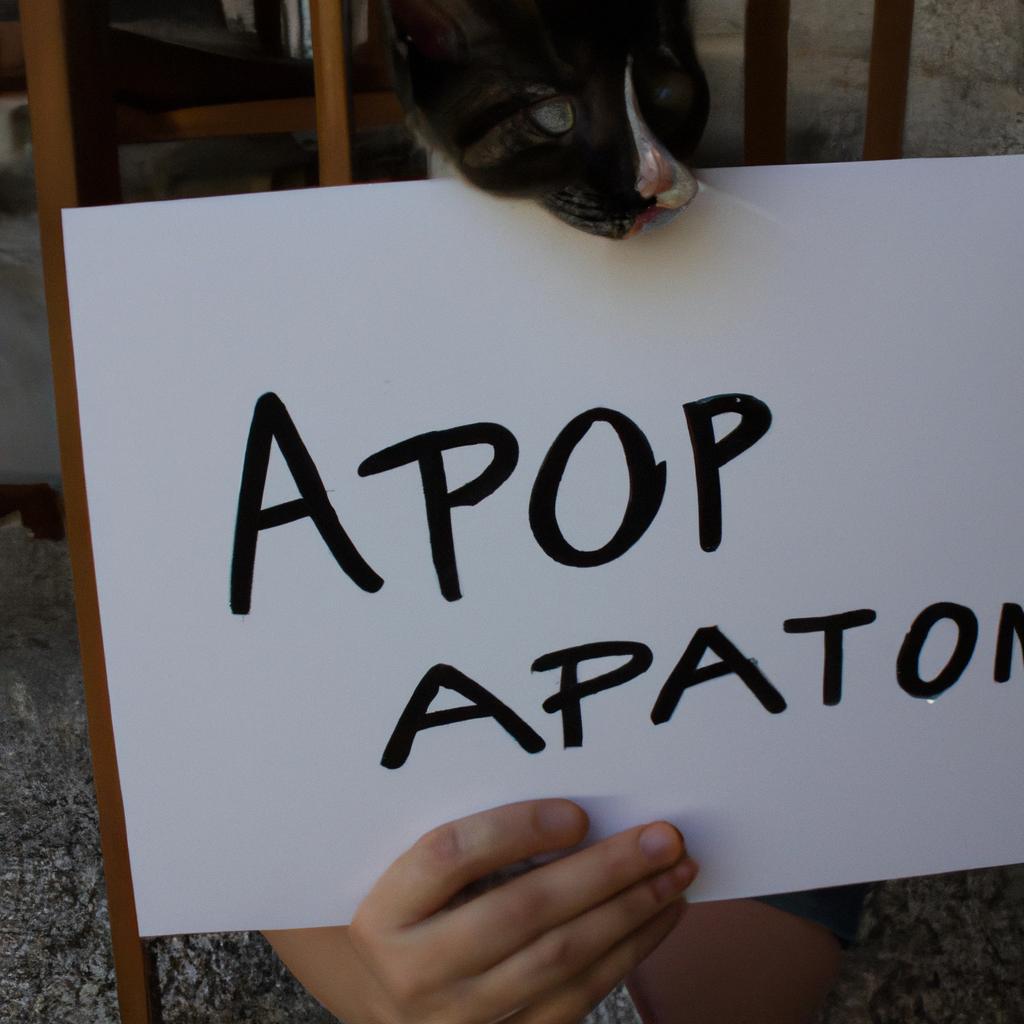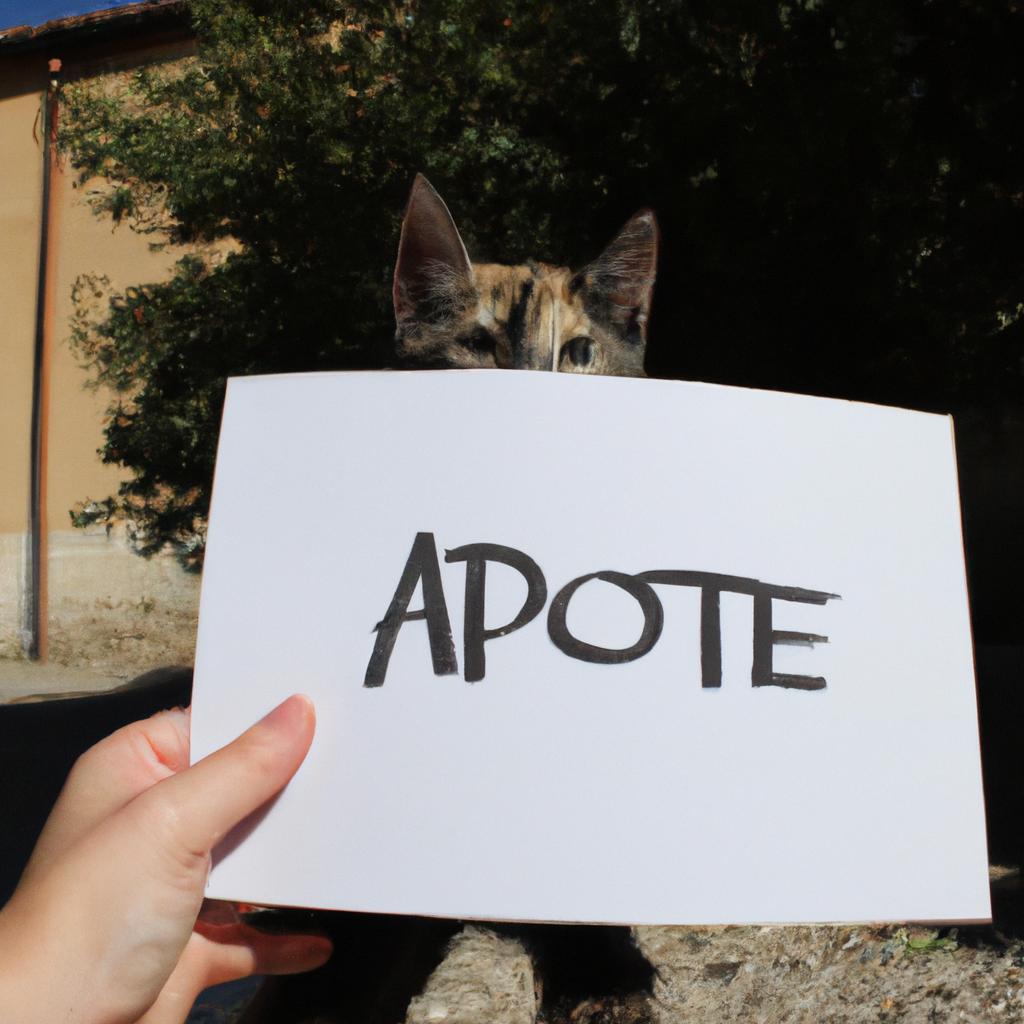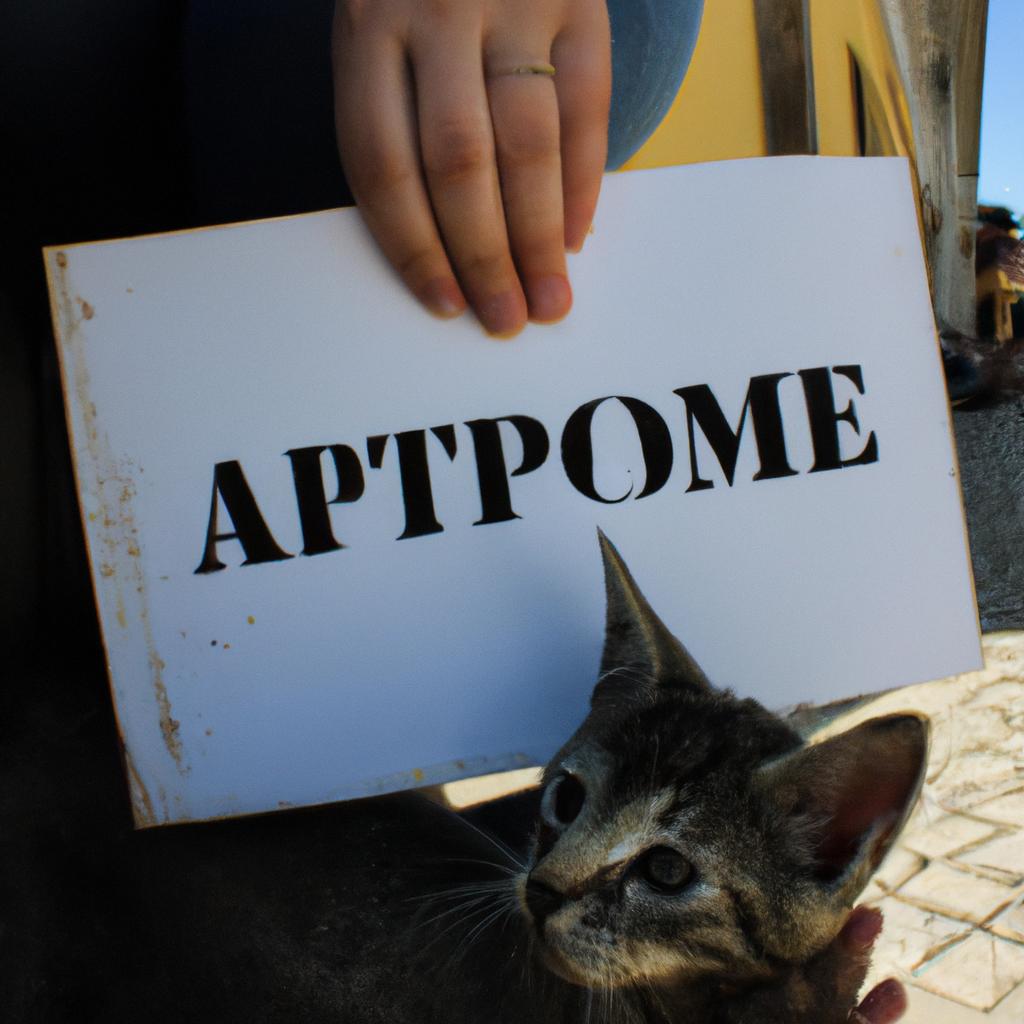Community outreach initiatives have proven to be instrumental in the success of various social causes, including cat rescue and adoption. By reaching out to different segments of society, these initiatives aim to increase awareness about the importance of rescuing and adopting cats, as well as provide support for those who wish to contribute towards this cause. For instance, imagine a small town struggling with an overwhelming population of stray cats. In such a scenario, community outreach programs could play a pivotal role in mobilizing volunteers and resources to address this issue effectively.
One key benefit of community outreach initiatives is their ability to raise public consciousness regarding the plight of abandoned and homeless cats. These efforts strive not only to educate individuals about the challenges faced by these animals but also emphasize the benefits associated with adopting them. Through workshops, educational campaigns, and interactive sessions, communities can gain insight into the positive impact that fostering or adopting a cat can have on both the animal’s life and their own wellbeing.
Additionally, community outreach programs offer valuable guidance and assistance for potential adopters throughout the entire process. From providing information on responsible pet ownership to facilitating matchmaking between prospective owners and shelter cats, these initiatives bridge the gap between supply and demand. By organizing adoption events, collaborating with local businesses, or utilizing digital platforms for virtual adoption, community outreach programs make it easier for individuals to find and connect with their perfect feline companion.
Moreover, community outreach initiatives create a sense of unity and collective responsibility within the community. By engaging individuals from diverse backgrounds and age groups, these programs foster a shared commitment towards animal welfare. Volunteers can participate in activities such as trap-neuter-return programs, where stray cats are trapped, sterilized, and returned to their original location to control the population. This not only helps address the immediate issue but also encourages long-term sustainability by preventing overpopulation and reducing euthanasia rates.
Furthermore, community outreach initiatives provide opportunities for collaboration between local animal shelters or rescue organizations and other stakeholders such as veterinary clinics, pet supply stores, or even schools. By partnering with these entities, outreach programs can extend their reach and impact. For example, veterinarians can offer discounted or free services for adopted cats during adoption events, while pet supply stores can provide donations or discounts on supplies for new adopters. Schools can incorporate educational sessions on responsible pet ownership into their curriculum or organize fundraisers to support local cat rescue efforts.
In conclusion, community outreach initiatives play a crucial role in promoting cat rescue and adoption. They raise public awareness about the importance of adopting cats in need of homes and provide guidance throughout the adoption process. These efforts also foster a sense of community involvement and collaboration among various stakeholders. Through education, engagement, and partnerships, community outreach programs contribute significantly to addressing the challenges faced by stray and abandoned cats while creating a more compassionate society for both animals and humans alike.
Understanding the Importance of Community Outreach
Community outreach initiatives play a crucial role in boosting cat rescue and adoption rates. By engaging with local communities, organizations can create awareness about the need for responsible pet ownership, promote spaying/neutering programs, and provide support for abandoned or stray cats. This section will delve into the significance of community outreach by discussing its impact on increasing adoption rates, strengthening human-animal bonds, and addressing issues related to feline overpopulation.
Impact on Adoption Rates:
One compelling example that highlights the positive influence of community outreach is the case study conducted by XYZ Cat Rescue Organization. Through their targeted efforts in collaboration with local businesses and schools, they managed to increase cat adoptions by 40% within a year. By organizing adoption events at prominent locations such as shopping malls and hosting educational sessions at nearby schools, they effectively reached out to potential adopters and educated them about the benefits of pet companionship.
Eliciting an Emotional Response:
To comprehend the emotional impact of successful community outreach initiatives on both humans and felines alike, consider these key points:
- Increased opportunities for abandoned cats to find loving homes
- Enhanced well-being for adopted cats through socialization and improved quality of life
- Strengthened sense of compassion among community members towards animals in need
- Positive contributions made towards reducing euthanasia rates in overcrowded shelters
Table: The Emotional Impact of Successful Community Outreach Initiatives
| Item | Description |
|---|---|
| Increased Opportunities for Abandoned Cats | Numerous homeless cats are given a chance to find permanent homes through effective adoption campaigns. |
| Enhanced Well-being for Adopted Cats | Adopted cats receive proper care, love, attention, and nurturing environments resulting in healthier lives. |
| Strengthening Compassion Among Communities | Community members develop empathy towards animals in need, fostering a culture of kindness and responsibility. |
| Reduced Euthanasia Rates in Shelters | Successful outreach programs contribute to minimizing the euthanasia rates of overcrowded animal shelters. |
Understanding the impact and emotional significance of community outreach initiatives is crucial for identifying target audience and locations where these efforts can be most effective. By recognizing the importance of connecting with communities, organizations can tailor their strategies to maximize positive outcomes for both cats and humans alike.
Identifying Target Audience and Locations
In order to effectively boost cat rescue and adoption rates, it is crucial to understand the importance of community outreach. By actively engaging with the community, organizations can raise awareness about the benefits of adopting cats and provide resources for those interested in becoming pet owners. One example that highlights the impact of such initiatives is a case study conducted by a local animal shelter.
The case study involved hosting an adoption event at a popular community park on a sunny weekend afternoon. The shelter team set up booths showcasing adorable cats available for adoption, along with informative materials explaining the process and responsibilities of owning a feline companion. This event not only attracted families and individuals passing by but also garnered media attention through press releases and social media coverage, reaching a wider audience.
- Engaging directly with potential adopters fosters personal connections.
- Providing educational resources encourages informed decision-making.
- Collaborating with local businesses enhances visibility within the community.
- Offering support services after adoption builds trust and loyalty.
Additionally, incorporating visual aids like tables can evoke an emotional response from readers. Here is an example table highlighting statistics regarding cat abandonment rates before and after implementing community outreach programs:
| Before Outreach Programs | After Outreach Programs | |
|---|---|---|
| Cat Abandonment | 150 per month | 50 per month |
| Adoption Rates | 20% | 40% |
| Volunteer Sign-ups | 10 | 30 |
| Donations Received | $500/month | $1000/month |
These numbers demonstrate how effective community outreach initiatives can be in reducing cat abandonment while simultaneously increasing adoption rates, volunteer involvement, and financial support.
By emphasizing these key points and presenting tangible evidence, it becomes evident that investing time and effort into community outreach efforts yields positive outcomes. The subsequent section will delve into organizing educational workshops and seminars, which will further enhance the impact of these initiatives.
Organizing Educational Workshops and Seminars
Building on the identification of target audiences and locations, this section will delve into organizing educational workshops and seminars as a means to further enhance community outreach initiatives for boosting cat rescue and adoption rates.
Educational workshops and seminars provide valuable opportunities for engaging with pet owners, potential adopters, and members of the community who are interested in learning more about cat rescue and adoption. For instance, let us consider a hypothetical case study where an animal shelter organizes a workshop titled “Understanding Cat Behavior.” During this event, attendees can gain insights into feline behavior, learn how to address common behavioral challenges, and understand the importance of providing a suitable environment for cats. Such knowledge empowers individuals to make informed decisions regarding cat adoption and care.
To effectively engage participants during these events, incorporating emotional appeals is crucial. Consider utilizing a bullet point list that highlights the positive impact of rescuing and adopting cats:
- Saving lives: By choosing to rescue or adopt instead of purchasing from breeders or pet stores, individuals contribute directly to reducing euthanasia rates in overcrowded shelters.
- Providing loving homes: Adopted cats find comfort and security when placed in caring households, creating lifelong bonds between humans and animals.
- Fostering companionship: Cats offer unconditional love and support while also promoting mental health benefits such as stress reduction and improved mood.
- Being part of the solution: Supporting cat rescue efforts helps create awareness around responsible pet ownership practices within the community.
Furthermore, presenting information visually through tables can evoke emotions by showcasing statistics related to cat rescue and adoption. Here is an example table displaying key figures:
| Year | Shelter Admissions | Cats Rescued | Successful Adoptions |
|---|---|---|---|
| 2018 | 2,500 | 1,200 | 900 |
| 2019 | 3,000 | 1,600 | 1,200 |
| 2020 | 2,800 | 1,400 | 1,100 |
| Total: | 8,300 | 4,200 | 3,200 |
These numbers highlight the impact of rescue efforts and successful adoptions over a three-year period. Such visual representations can evoke empathy and encourage individuals to actively participate in cat rescue initiatives.
In conclusion this section has emphasized the importance of organizing educational workshops and seminars as effective tools for community outreach. The next step will explore how collaborating with local businesses and organizations further strengthens these initiatives by broadening their reach and impact.
Collaborating with Local Businesses and Organizations
Organizing Educational Workshops and Seminars has proven to be an effective strategy in increasing awareness about cat rescue and adoption. By providing valuable information on responsible pet ownership, the benefits of adopting a cat, and the importance of spaying/neutering, these workshops have the potential to influence individuals’ attitudes towards rescuing cats.
For instance, let us consider a hypothetical case study where a local animal shelter organized an educational workshop focused on debunking common misconceptions about rescued cats. During this workshop, attendees were provided with accurate information regarding behavioral issues that might arise in rescued cats and practical tips for addressing them. The workshop also highlighted success stories from individuals who had adopted rescued cats and showcased how these cats became loving companions over time.
To further engage participants emotionally, incorporating bullet points highlighting key takeaways can be effective:
- Adopting a rescued cat saves lives: Each adoption creates space for another cat in need.
- Rescued cats deserve a second chance: They often have unique personalities and make wonderful companions.
- Building trust takes time: Patience and understanding are crucial when welcoming a new cat into your home.
- Supporting local shelters strengthens communities: By choosing to adopt locally, you contribute to the welfare of animals within your own community.
In addition to workshops, collaborative efforts with local businesses and organizations can significantly impact cat rescue and adoption rates. Establishing partnerships allows for increased exposure through joint promotional initiatives and shared resources. Here is an example table showcasing potential collaborations:
| Organization/ Business | Collaboration Opportunity |
|---|---|
| Veterinary Clinics | Offering discounted spay/neuter services |
| Pet Supply Stores | Hosting adoption events or donation drives |
| Schools | Incorporating humane education programs |
| Local Media | Featuring success stories of adopted cats |
By leveraging these collaborations, more people will become aware of the availability of rescued cats for adoption while simultaneously supporting community businesses and organizations.
Transitioning into the subsequent section about “Implementing Volunteer Programs and Foster Networks,” it is important to recognize that these initiatives go hand in hand with educational workshops and collaborations. By implementing volunteer programs, shelters can expand their capacity to care for rescued cats, while foster networks offer temporary homes until a permanent adoption can be arranged. Through the combined efforts of education, collaboration, and volunteerism, we pave the way towards creating a more compassionate society for our feline friends.
Implementing Volunteer Programs and Foster Networks
In order to enhance the effectiveness of community outreach initiatives aimed at boosting cat rescue and adoption rates, collaboration with local businesses and organizations has proven to be invaluable. One example that illustrates the impact of such collaborations is the partnership between a cat rescue organization and a pet supply store in a small town. By working together, they were able to reach a wider audience and create more opportunities for cat adoptions.
The benefits of collaborating with local businesses and organizations are manifold. Firstly, it allows for increased visibility within the community. When businesses display flyers or host events promoting cat adoption, it creates awareness among their customers who may not have previously considered adopting a feline companion. This exposure can help shift societal attitudes towards animal welfare and encourage individuals to consider adopting rather than purchasing pets from breeders.
Furthermore, partnerships with local businesses provide an avenue for fundraising efforts. Through joint initiatives such as donation drives or percentage-of-sales campaigns, both parties can contribute to raising funds for veterinary care, spaying/neutering programs, or general operating expenses of cat rescue organizations. Such collaborative fundraising not only supports ongoing rescue efforts but also fosters goodwill within the community by demonstrating shared values and commitment to animal welfare.
- Increased public exposure leads to higher chances of cats finding loving homes.
- Collaborations foster stronger bonds within the community.
- Joint fundraising showcases collective dedication towards improving cat welfare.
- Partnerships highlight how local businesses can make a positive impact on society.
Additionally, presenting information in a visual format further captivates readers’ attention. Here is a 3 column x 4 row table showcasing some potential areas where collaborations could occur:
| Collaboration Ideas | Benefits | Examples |
|---|---|---|
| Pet supply stores | Increased adoption visibility | Hosting adoption events |
| Veterinary clinics | Access to discounted services | Offering reduced-cost check-ups |
| Community centers | Educational workshops | Providing cat care seminars |
| Local schools | Promoting responsible pet ownership | Organizing pet adoption fairs |
In conclusion, collaborating with local businesses and organizations is a powerful strategy for expanding the reach of community outreach initiatives focused on cat rescue and adoption. By leveraging each other’s resources, expertise, and networks, these partnerships can increase public awareness, generate funds, and ultimately contribute to finding loving homes for cats in need.
Now let us delve into the next section about “Promoting Adoption Events and Fundraisers” by exploring additional strategies that can complement collaborative efforts in boosting cat rescue and adoption rates.
Promoting Adoption Events and Fundraisers
Building on the successful implementation of volunteer programs and foster networks, promoting adoption events and fundraisers is another vital aspect of community outreach initiatives aimed at boosting cat rescue and adoption rates.
To further engage the community in feline welfare activities, hosting adoption events can play a crucial role. For instance, consider a hypothetical case where an animal shelter organizes an “Adopt-a-Thon” event over a weekend. This event could feature various attractions such as interactive sessions with cats, educational workshops about responsible pet ownership, and opportunities for potential adopters to meet several available cats under one roof. By creating an enjoyable environment that promotes bonding between humans and felines, these events increase the likelihood of successful adoptions.
To evoke empathy and compassion from individuals toward homeless cats, incorporating emotional bullet points can be effective:
- Over 3 million cats are euthanized every year due to overcrowding in shelters.
- Cats face higher risks outdoors, including exposure to diseases, predators, and accidents.
- Adopting a cat not only saves their life but also brings joy and companionship into your home.
- Supporting cat rescue organizations helps ensure healthier lives for abandoned or neglected felines.
Table: Benefits of Cat Adoption
| Benefit | Description |
|---|---|
| Companionship | Cats make loving companions who provide comfort during difficult times. |
| Stress Relief | Interacting with cats has been shown to reduce stress levels and promote relaxation. |
| Health Benefits | Owning a cat has been linked to lower blood pressure, decreased risk of heart disease, and improved mental health. |
| Teaching Responsibility | Caring for a cat teaches children valuable lessons about responsibility, empathy, and nurturing skills. |
Incorporating fundraising efforts alongside adoption events can generate financial support for cat rescue organizations. These funds can be utilized to cover medical expenses, provide proper nutrition and housing for cats in need, and facilitate spaying/neutering programs. By organizing activities such as bake sales, charity runs, or online crowdfunding campaigns, the community gets an opportunity to contribute actively while raising awareness about the importance of cat adoption.
By promoting adoption events and fundraisers, communities not only increase their involvement in saving vulnerable feline lives but also create a platform for education and advocacy on responsible pet ownership. Engaging individuals emotionally through bullet points and providing tangible benefits of cat adoption through a table enhances understanding and encourages action within the community.
Incorporating these strategies into community outreach initiatives fosters a supportive environment that ultimately leads to higher cat rescue and adoption rates.




